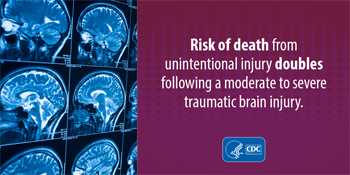TBIs and Injuries
 Prevent TBIs and future unintentional injuries by understanding the risks.
Prevent TBIs and future unintentional injuries by understanding the risks.
Brain Injury Awareness Month is an important time to highlight the lifelong effects of a traumatic brain injury (TBI). A TBI is caused by a bump, blow, or jolt to the head, or a penetrating head injury that disrupts the normal function of the brain. People who have had a moderate to severe TBI may experience changes in thinking and balance, which may put them at greater risk of later unintentional injuries. TBIs also increase the risk of dying from several other causes. For example, compared to people without TBI, people with TBI are more likely to die from:
- Seizures: 50 times more likely
- Unintentional drug poisoning: 11 times more likely
- Infections: 9 times more likely
- Pneumonia: 6 times more likely
The leading causes of TBIs include falls among older adults, being struck by or against an object, assaults, and motor vehicle crashes. Current efforts to reduce unintentional injuries include preventing older adult falls, improving sports concussion culture, and increasing motor vehicle safety. This public health approach to injury prevention can reduce the rate of TBI and its long-term consequences.

Traumatic brain injury is a major cause of death and disability in the United States.
Preventing Older Adult Falls
According to CDC data, almost 8 out of 10 TBIs among older adults are caused by a fall. Emergency department visits more than doubled from 2007–2013, reaching more than 394,000 visits. Hospitalizations increased by almost 50 percent, resulting in more than 91,000 stays. Falls are preventable. Here are some steps that older adults can take to prevent falls:
- Talk to your doctor.
- Do strength and balance exercises.
- Have your eyes checked.
- Make your home safer.
- Learn more about older adult falls on the STEADI website.
Improving Sports Concussion Culture
CDC has a new educational gaming app designed to teach children 6-8 years old about basic concussion safety. Children can learn the benefits of playing it safe and smart through a futuristic world of galactic racing adventures. The app teaches children about the different ways the brain can get hurt during sports activities and how important it is to tell a coach, parent, or other adult when an injury occurs. Learn more about this free app here!
Based on our research, we know that prevention is possible. We’ve made youth sports concussion one of our focus areas, but we can’t solve this issue alone. All of us play a role in creating a culture of concussion safety. Here’s how:
- Change the “win-at-all costs” mentality.
- Talk to your athletes about concussion.
- Model, expect, and reinforce safe play.
- Get concussion information on every sideline. Learn about Opportunities to Reshape the Culture Around Concussion in Sports.
Increasing Motor Vehicle Safety
For youth and young adults, motor vehicle crashes were the main cause of TBI-related deaths, and accounted for 56% of TBI-related deaths among 5 to 14 year-olds, and 47% of TBI-related deaths for 15 to 24 year-olds from 2006–2010. Everyone can improve motor vehicle safety by:
- Using seat belts on every trip, no matter how short. Make sure passengers buckle up too.
- Buckling children in age and size appropriate car seats, booster seats, and seat belts. Those ages 12 and under should be buckled in the back seat.
- Choosing not to drive after drinking alcohol or using drugs and helping others do the same.
- Knowing your state’s graduated driver licensing laws, and consider using tools such as CDC’s parent-teen driving agreement if you are the parent of a teen driver.
- Learn more about all of these tips on the Motor Vehicle Safety website.
Learn More About Traumatic Brain Injury
Traumatic brain injuries are a serious public health problem in the United States. TBIs are a major cause of death and disability contributing to about 30% of all injury deaths. Every day, 138 Americans die from injuries that include TBI. Those who survive a TBI can face effects lasting a few days to disabilities which may last the rest of their lives. Effects of TBI can include impaired thinking or memory, movement, sensation (e.g., vision or hearing), or emotional functioning (e.g., personality changes, depression). These issues not only affect individuals, but can have lasting effects on families and communities. To learn more about TBIs, visit:
- Page last reviewed: March 21, 2017
- Page last updated: March 21, 2017
- Content source:
- National Center for Injury Prevention and Control, Division of Unintentional Injury
- Page maintained by: Office of the Associate Director for Communication, Digital Media Branch, Division of Public Affairs




 ShareCompartir
ShareCompartir